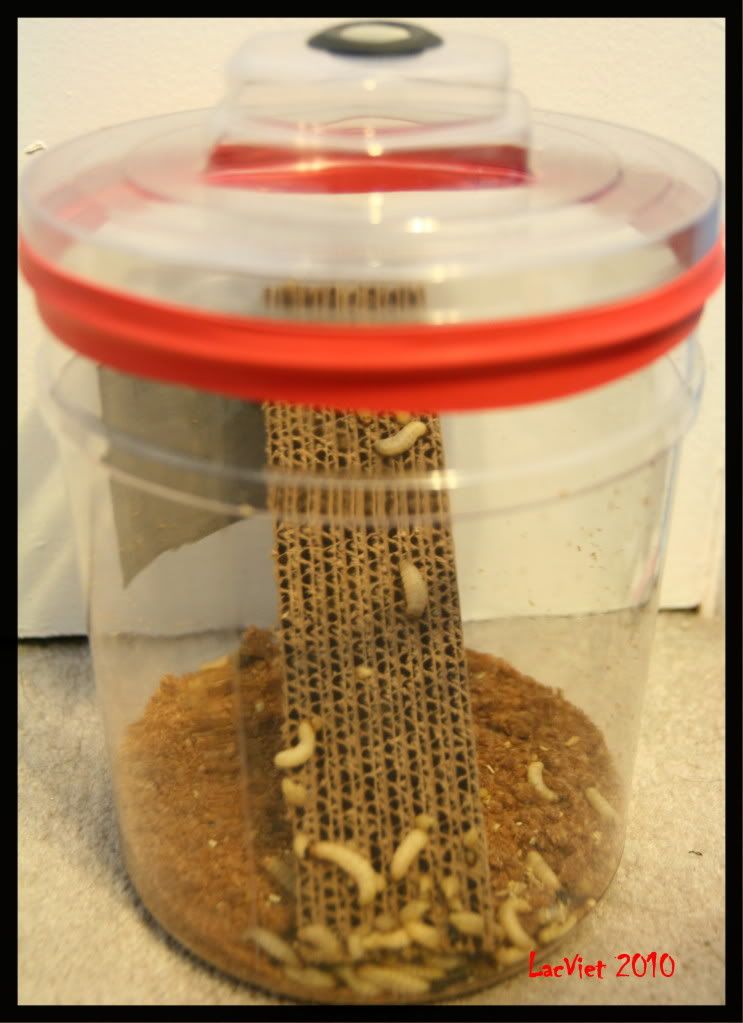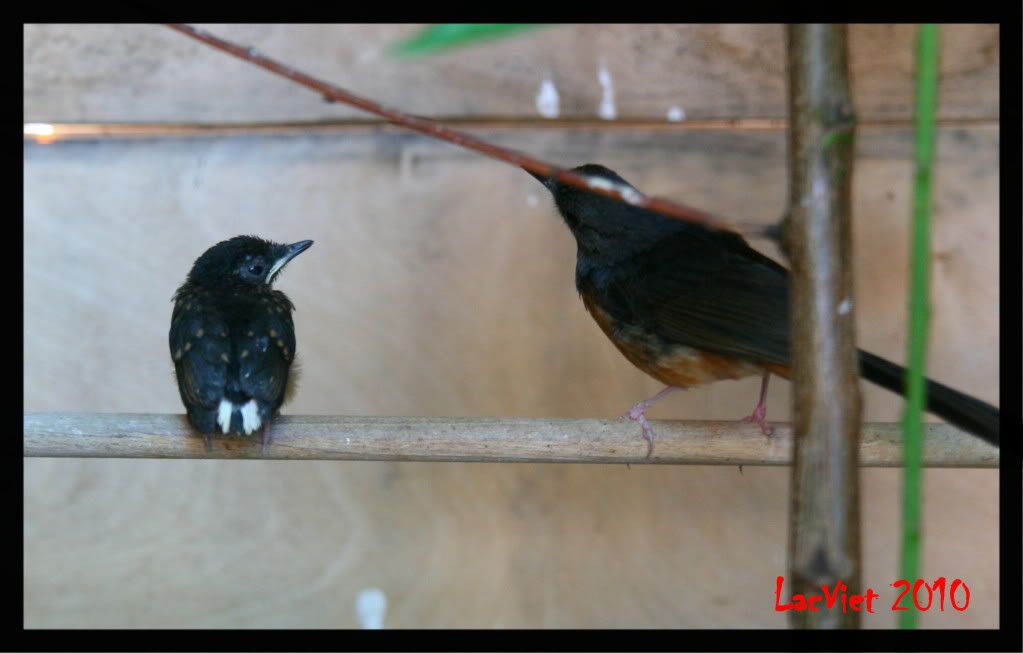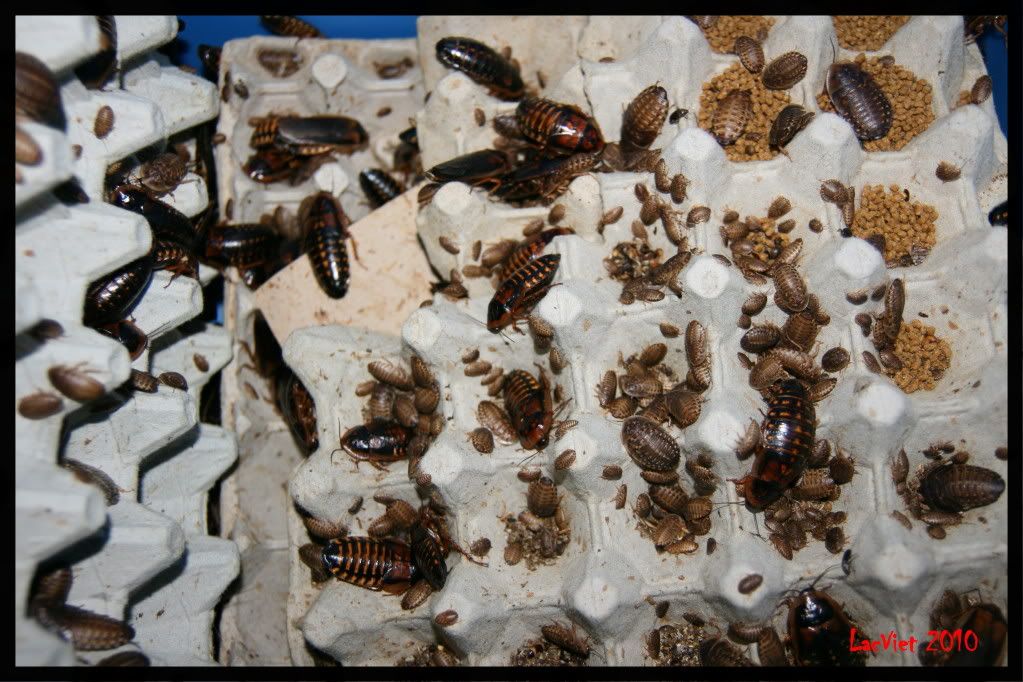Earthworm that I found in my backyard during digging the soil can be an additional food source for the shama thrush. I know these earthworms are safe to feed the birds because I do not spray any insecticide/ or any harm chemical in my yard. All the birds are eating the earthworms and even feed to their chicks if given plenty. My backyard doesn't big enough to have unlimited supply of earthworms so I consider feeding earthworms as treat food, not a staple food that can be feed everyday.
This blog is a repository of information on the White-rumped Shama (Copsychus malabaricus) including breeding information, and other songbirds/pets that I keep from time to time. I can be contacted at lacvietcrct@gmail.com.
Tuesday, August 24, 2010
First time raising waxworm for bird
This is the breeding waxworm kit that I bought from the internet a while ago but haven't have a chance to set up until now. The kit contains a clear plastic container with lid, food for waxworm, and egg laying material. The lid have small screen mesh on top to allow air exchange. Egg laying material is just like a carton box that cut and glue to resemble a bee nest. Waxworm when mature will turn to a moth and lay eggs inside bee nest so basically anything that have multiple of small holes that the moth can lay eggs into can be use. As for the food, I have to buy the food as I don't know the entire contents of it but I know it has honeybee since the waxworm feed on wax/honeybee in nature.
If you want to read more on how to raise waxworm, you can read this post that I posted a whild back: http://lacvietchoelua.blogspot.com/2010/01/breeding-wax-worm-another-live-food-for.html as it has links to where to purchase a breeding kit as well as article on breeding/raising them.
If you want to read more on how to raise waxworm, you can read this post that I posted a whild back: http://lacvietchoelua.blogspot.com/2010/01/breeding-wax-worm-another-live-food-for.html as it has links to where to purchase a breeding kit as well as article on breeding/raising them.
Monday, August 23, 2010
WOOT, I finally have some fertile serama eggs
After 20 or so eggs laid by the serama hen that are infertile, finally I have 3 eggs that are fertile. I don't really know the reason why the roo can't do his job properly, but that's ok with me as I'm not into breeding this type of chicken. I only keep them as pets and if they happens to have chicks, I might raise them up and give away to my friends who ever want them.
Here is a pic of fertile egg at about 8 days old in the incubation. You can see few blood vessels are forming and tiny chick at the middle right.
Here is a pic of fertile egg at about 8 days old in the incubation. You can see few blood vessels are forming and tiny chick at the middle right.
Saturday, August 21, 2010
Last chicks of the season???
These chicks might be the last few chicks of the season. Total of 3 chicks left the nest today. Not sure the female will lay another round of eggs and if the male can still have enough form to fertilize. Last year, 7th clutch was infertile.
Sunday, August 15, 2010
Another live food source: Blaptica Dubia
If you remember, I posted a while back about my friend DT who breeds crickets, mealworms, superworms, Blatta lateralis, and Blaptica dubia (http://lacvietchoelua.blogspot.com/2010/01/build-your-own-supply-of-live-insect-to.html). I copy DT's footstep and also try to breed B. lateralis (about 1.5 years ago) and B. dubia (about a year ago). I start out with about 300 mix/adult D. dubia and about a year later, I would say that I still have at least 3,000 dubia roaches right now (very conservative number) with regular weekly feeding of about two hundred or so roaches to all of the birds for the last 3-4 months. The adult roach can reach close to 2in in length and mature at around 5 months. I think they are slow growth compare to B. lateralis, but they are slower than B. lateralis and almost no smell at all. When feeding these roaches to the shama thrush, only smallest babies or immature roaches at around 1cm can be feed as these roaches are almost round shape when at 1 inch long or less. Bigger roaches (1 inch or more in length) has relative hard shell and too big for the shama thrush to tear into small bite size. It would take very long time for the shama thrush to eat big roach so I only feed small one.
These B. dubia roaches are very easy to keep as long as some basic requirements are met. Keep them warm and provide regular food (anything from dried food for bird, fish, dog, cat, etc... to fruits, carrots, potato, and most veggies)/water are the only two requirements (beside container to keep them) to success keeping and breeding these roaches. They are very hardy and not easy to die like crickets. In no time, anyone who keep them can have lots and lots of baby roaches. Because of slow growing and mature rate, starting with few hundred roaches can be enough to feed one or two shama thrush all year round without the need to buy other live foods (but I still believe feeding variety of live foods will keep the shama thrush healthy and thrive in long term in captivity).
One other note, I found that most shama thrush will choose to eat crickets over B. dubia or B. lateralis if given a choice. They also pick crickets to feed their young over B. dubia or B lateralis if given a choice. The reason is the outer cover of crickets is much softer than the roaches and maybe the taste is better :-))
These B. dubia roaches are very easy to keep as long as some basic requirements are met. Keep them warm and provide regular food (anything from dried food for bird, fish, dog, cat, etc... to fruits, carrots, potato, and most veggies)/water are the only two requirements (beside container to keep them) to success keeping and breeding these roaches. They are very hardy and not easy to die like crickets. In no time, anyone who keep them can have lots and lots of baby roaches. Because of slow growing and mature rate, starting with few hundred roaches can be enough to feed one or two shama thrush all year round without the need to buy other live foods (but I still believe feeding variety of live foods will keep the shama thrush healthy and thrive in long term in captivity).
One other note, I found that most shama thrush will choose to eat crickets over B. dubia or B. lateralis if given a choice. They also pick crickets to feed their young over B. dubia or B lateralis if given a choice. The reason is the outer cover of crickets is much softer than the roaches and maybe the taste is better :-))
Thursday, August 12, 2010
Venomous spider as food for the Shama Thrush?
The picture below are some of the widow spider that I found in the backyard. I know these spiders are highly venomous and great harm can occur if get bitten. In the US, these little spiders can be found almost everywhere in the backyards, gardens, or any secluded, protected sites around the house. Total of 5 species of widow spider in the US and judging from the picture that I took, there are at least 2 species of widow spider: the infamous black widow spider and the brown widow spider. At night with long forceps and a flashlight, those spiders are easy catch. I usually catch around 20 adult widow spiders every couple of months and feed to all of my Shama Thrush on the next day. I killed the spider first before feeding to the bird and all of the birds just love to eat those spiders. So far, I have feed all of my shama thrush widow spider (few spiders every couple of months for each bird) for the last 2 years without any adverse effect to the bird. In fact, the bird just went crazy when seeing a spider and just can't wait to eat one just like giving candy to kid. :)
I don't know any benefit to the bird by eating spider but according to few researched paper, spider in general contains high level of taurine acid. Feeding baby bird with high taurine acid food, according to article in sciencedaily.com "... were on average much bolder and better at learning in adulthood, than their counterparts who were not fed the extra taurine." (http://www.sciencedaily.com/releases/2007/08/070824220328.htm) During the last 2 years of giving few spiders to the bird, I did not see parent shama bird feed their chicks any spider. The parents always eat all the spiders that I give them.
I don't know any benefit to the bird by eating spider but according to few researched paper, spider in general contains high level of taurine acid. Feeding baby bird with high taurine acid food, according to article in sciencedaily.com "... were on average much bolder and better at learning in adulthood, than their counterparts who were not fed the extra taurine." (http://www.sciencedaily.com/releases/2007/08/070824220328.htm) During the last 2 years of giving few spiders to the bird, I did not see parent shama bird feed their chicks any spider. The parents always eat all the spiders that I give them.
Tuesday, August 10, 2010
Subscribe to:
Posts (Atom)









